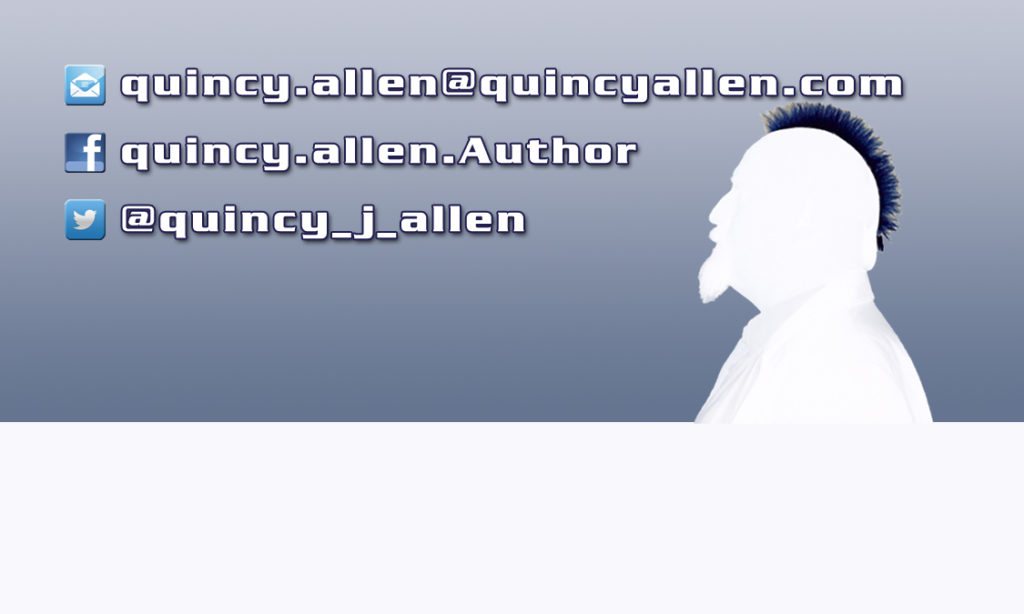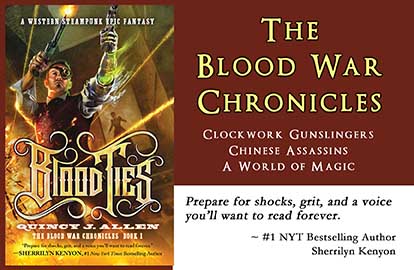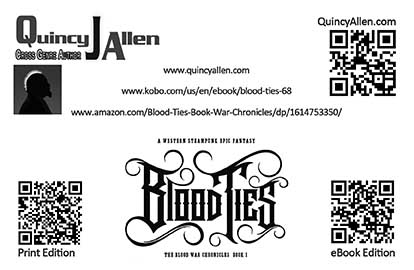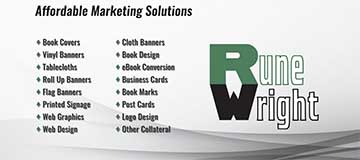BRANDING AND COLLATERAL
On the day you decide to make a career out of your writing, there are some things you need to consider as you work towards getting your name and face out in the real world. The first is that all writers are entrepreneurs—business owners—and you need to behave as such.
In some regards, I’m putting the cart before the horse here, but there is a method to my madness. When I set off down this road towards fortune and glory (yeah, right… fortune and glory… cough cough), I actually gave a great deal of thought to branding.
I come from IT, but back in those days, my department worked closely with the marketing department. “Branding” is just what old cowpunchers thought it to be. It’s a mark on your property that can’t be confused with someone else’s cow. When someone looks at your brand, they know immediately what they’re looking at, and if you do it right, they know what they’re getting. Now, this can be a double-edged sword, in that, with good branding, the good sticks with you wherever you go, bot so can the bad.
So, about seven years ago now, I woke up one day and decided to be a writer. I was already over forty years old, and I was planning to start a new career path with a very low success rate, when it comes right down to it.
Talk about a gamble.
So, I needed a gimmick… that’s really the only word for it. I needed something that would immediately set me apart from the pack, make me immediately recognizable, and (hopefully) resonate with people when I was “out in public.” Now, by public, I mean at genre conventions. If you’re a writer, the odds are you will need to get in front of people at conventions, book signings, seminars, and pretty much every other damn place where you can be seen holding, and hopefully signing your book. I’ll talk about how to sell your books in a later post. This is about branding.
So, I knew I needed something to set me apart… Have you seen my hair? That was it. It was a fast, simple, easy thing that didn’t cost money and would absolutely be something that people would remember and which would resonate with most folks at conventions. Granted, I combine it with a stout, six-foot frame, so the appearance has been striking everywhere I go. But there are plenty of big guys in this business, and I wanted to set myself apart from them as well and NOT do it with clothing. (I’ll talk about kilts later, too).
 With one very important haircut behind me, I needed to capitalize on the hawk and make sure that people saw it everywhere they saw my stuff. Can you say logo? So, one sunny afternoon, when I was having some pictures taken, it occurred to me that I could really capitalize on the hawk with just a little bit of Photoshop magic.
With one very important haircut behind me, I needed to capitalize on the hawk and make sure that people saw it everywhere they saw my stuff. Can you say logo? So, one sunny afternoon, when I was having some pictures taken, it occurred to me that I could really capitalize on the hawk with just a little bit of Photoshop magic.
I had the photographer take a silhouette photo, and then I went to work with my graphics software. The intention was to create something cool, special, and unique, that nobody else in this business used. And then take that image, that branding, and include it on everything I did.
Now, I’m not suggesting that you go out and change your hair or get a tattoo or do anything else dramatic. Your branding can be something as simple as a “look” or a garment or just about anything. Kevin J. Anderson does the black suit. James Artimus Owen does the black vest. Butcher has the muscles and hair. Stephen Brust has his hat, and R.A. Salvatore goes with polos and the goatee. Keep in mind that branding can be both affected and non-affected. A mohawk, by definition, can be considered an affected look, but in my case, I like to think I pull it off pretty naturally. I’m irreverent, have issues with authority, and I have the right skull for a mohawk, even when it’s just a little off center. What can I say, I’m right handed and I maintain this bad boy myself.
The point here is that you want to maintain something consistent when you’re in front of your fans and potential fans. You want them to be able to pick you out of a crowd, and at a distance if you can manage it. And then, again, if you can manage it, you want that branding to be on everything you do.
You will find my logo (which is an image of my mohawk) on my business cards (that double as bookmarks), my website, my banners, my tablecloths, and my books. It’s frigging everywhere, and that is entirely on purpose. I’ve planned this from day one, and you should too.
 Also, as part of your branding, you’ll want your author name to always look the same. It’s part of your logo and can be the only part of your logo if necessary. The point is that on ALL of your collateral, that name will appear the same… same font, same color, same layout, same everything. There are entire marketing departments in corporations who make boatloads of money maintaining corporate branding and getting that brand in as many places as possible.
Also, as part of your branding, you’ll want your author name to always look the same. It’s part of your logo and can be the only part of your logo if necessary. The point is that on ALL of your collateral, that name will appear the same… same font, same color, same layout, same everything. There are entire marketing departments in corporations who make boatloads of money maintaining corporate branding and getting that brand in as many places as possible.
Ultimately, it becomes a business decision. You invest time and money in building and promoting your brand. Don’t waste energy by sending different messages. You want one brand, one message, one channel for your customers to find you. The moment you have mixed messages, you have missed opportunities, wasted time, and therefore left money on the table if not outright wasted it.
So, what marketing collateral do you need?
LOGO
If you can manage it, create an LLC or other business entity to represent your author name (whether it’s a pen name or not) and then pay a graphic designer to do a proper logo to depict your name. The designer will need to be aware that this logo must work across all media (print and digital), have both two-color and four-color versions, and be re-sizable from a centimeter tall to billboard size. And they need to present you a complete file set so that you can use your logo anywhere and any time you need it without going back to the artist.
Trust me on this one. The first time you have to pay a second artist to recreate your logo because the first artist disappeared on you and only gave you 72DPI images, you’ll know precisely what I’m talking about.
BUSINESS CARDS
 You need business cards. Period. My business card has coloring and layout to match my website, my mohawk, my logo, a product list (cross genre with all of the main ones I write in), my URL, all my social media links, a place for an autograph.
You need business cards. Period. My business card has coloring and layout to match my website, my mohawk, my logo, a product list (cross genre with all of the main ones I write in), my URL, all my social media links, a place for an autograph.
You’ll want two sided, and I recommend plastic cards because they make a perfect and durable book mark that your fans can use to mark the page and get back to your site. I say that, because I slip my card into every single book I autograph.
Every one.
 Be prepared to hand out your card everywhere you go, and always keep some in your purse or wallet so that when you’re talking to the clerk at the store or someone at the animal shelter, and you tell them what you do, you can hand off your card and have them check out your stuff on the website.
Be prepared to hand out your card everywhere you go, and always keep some in your purse or wallet so that when you’re talking to the clerk at the store or someone at the animal shelter, and you tell them what you do, you can hand off your card and have them check out your stuff on the website.
WEBSITE
Get thee a website!
You website should be fully branded. It should also include a complete list of your books and links to every platform where you sell your books. I recommend WordPress, because it doesn’t take a rocket scientist to update it. If you don’t know where to begin when it comes to getting your website, then pay someone to do it for you.
You need to have a web presence, AND you need to have your email go through your website domain. Get rid of your Gmail account right now. Forget Yahoo. You want your name everywhere, and you want people to use it whenever they want to communicate with you. This ties into branding as well as making it easy for your customers to get to you. The goal is to give potential customers absolutely no excuse to keep from finding you.
There are some basic categories you’ll want as well. Your home page should be basically a blog page. Try and put out posts on a regular or at least semi-regular basis. I’ve been TERRIBLE about this for the past few years, but I’m working deliberately towards correcting what really is an oversight.
Additionally, when you blog, you’ll want to mix up the types of messaging. The most critical, is mentioning when you have new books out. However, be judicious about this. Don’t be just a “buy my books” commercial. Having said that, you’ll get the most miles out of being helpful on your page. That’s part of what these Book Biz posts are about. I’m trying to pay something forward.
My motivation is two-fold. I really do like helping authors up their game, and with all the mistakes I’ve made over the past few years, I figure I can help at least a few people avoid a few landmines. But, in drawing authors to my website, I’m also encouraging them to hopefully share out my posts when I am selling something.
Is that mercenary? Absolutely. Is it wrong? Absolutely not.
You need to be calculating in your business endeavors, but do so without taking advantage of others or abusing the trust they put in your brand. It’s a fine line, and I’m sure I’ve stumbled here and there, but I always try to maintain that ideology.
I also have a section on my site for Author Resources. This falls into the same category as the Book Biz blogs. I want to help authors and, in turn, hope that they can help me.If you have a hobby, put posts up about that. My biggest hobby is cooking, so I have a limited but growing section of recipes. I also do motorcycles, but I haven’t been able to ride for two years. This year will be different, and I’ll be blogging about that as well. What’s important is that you connect with people of similar interests. They will be more willing to buy your books, because you have a connection.
You’ll obviously want to have all of your available titles listed on your site, and there are plenty of add-ins for authors to list books with all the links, covers, and metadata to properly display them.
POSTCARDS
 Postcards are a nice way to promote new titles, although they are not necessary. I’ve been doing this for seven years, and I’m only now having my first post card done. I’m working towards promoting the Blood War Chronicles, especially now that I have the first of the new covers out. I’m also highlighting that Sherrilyn Kenyon was willing to provide a blurb for me. The card has a very specific purpose, and I’m keeping it as limited as possible. I don’t recommend them to promote your core brand, by the way. That’s what your business card is for.
Postcards are a nice way to promote new titles, although they are not necessary. I’ve been doing this for seven years, and I’m only now having my first post card done. I’m working towards promoting the Blood War Chronicles, especially now that I have the first of the new covers out. I’m also highlighting that Sherrilyn Kenyon was willing to provide a blurb for me. The card has a very specific purpose, and I’m keeping it as limited as possible. I don’t recommend them to promote your core brand, by the way. That’s what your business card is for.
 Postcards are for specific and at least marginally temporary purposes, like a book launch, a sale, or a special event. A good post card can also be a quick, cheap, and easy way to drive traffic to new IPs (intellectual properties), special offers, and purchasing products that you couldn’t get to the show you’re at.
Postcards are for specific and at least marginally temporary purposes, like a book launch, a sale, or a special event. A good post card can also be a quick, cheap, and easy way to drive traffic to new IPs (intellectual properties), special offers, and purchasing products that you couldn’t get to the show you’re at.
You’ll generally want two sided, full color front, and a black & white back. Finally, the information on your card should serve several specific purposes. You want it to be eye-catching (see the cover), you’ll want it to have who and what you are promoting (see IP and blurb), your branding (see the QJA logo and mohawk), any appropriate URLs or event information for your clients to glom onto, and if dealing with URLs, a QR code so that you can capitalize on smart phone technology and impulse buying.
Note, you can find sites on line that will generate QR codes for free. However, having said all that, you would be well advised to pay a professional for your typesetting. Don’t just slap something together. Pay a professional $50 or $100 to do the job right. Postcards have to be as eye-catching as a book cover and contain as much critical information as a book jacket.
TABLECLOTH
The day you decide to start getting your own table at conventions or other events, get yourself a tablecloth.
You need one. Believe me. That tablecloth will set you apart from 75% of the competition, and at shows, you are in competition with your author neighbors as well as the folks selling corsets or t-shirts across the aisle from you.
A tablecloth makes you look professional. It shows to potential readers that you are taking your writing career seriously and they can’t just discount you as another quack who decided to string together a lot of incomplete sentences and sell them inside a glossy cover.
All of the considerations that you put into both a business card and, to a lesser extent, a postcard, should factor into what you have on your tablecloth. If you want something permanent in order to keep costs down, then it should be like the business card.
You’ll want to either focus on one IP or have something like your entire library displayed. Backgrounds are important. Fonts and font sizes are important. Colors are also important, and if you don’t know how or even why those things are critical, then pay a pro. Also, you may want to have two tablecloths made: an eight-foot and a six-foot version. Not all cons are alike, and sometimes they’ll give you a small, six-foot table in author alley, while other times you’ll get you an eight-foot table down in the arena with the big boys.
Keep in mind that I’ve included an image of my small business tablecloth. Because I have been in the WFP and Rabid FanBoy booths, I haven’t needed a tablecloth. I will, however, be getting one for when I do other shows. The rules for my tablecloth will be the same as they are for the business card and will probably have book covers for each of my series.
BANNERS
 A banner can be a great way to set yourself apart from others, especially if you don’t have a table to work with. A good rollup banner has a great price point, is very portable, and can present both your brand and a specific IP.
A banner can be a great way to set yourself apart from others, especially if you don’t have a table to work with. A good rollup banner has a great price point, is very portable, and can present both your brand and a specific IP.
Banners are something that can carry information that would be on both a business card and a post card. Some information is permanent, while some can be very temporary. Because they have a lower price point, these things can be considered at least marginally temporary.
You’ll notice in the image here that I have nearly all of my book covers listed on my current banner. This one (which I’ve been using for a while) is about to get upgraded, but I’m holding off until the new cover for Blood Curse is available. Once it is, I’ll be updating the covers at the top. I also have some new titles to add to the banner, and I want to add some QR codes so that people can buy my books even if the books themselves are not anywhere around.The key is to always be thinking about how you can both directly and subtly drive customers towards your books. We’re in this game to earn a living, and the only way you do that is by getting people to that decision point of if they want to buy your book and then give them every reason in the world to say yes.
So, that’s it. Those are some key facets of your branding effort, and you’ll want to make a concerted effort towards defining and presenting your brand. You don’t necessarily have to do it the way I did it, but if you do nothing, you’re leaving money on the table and fans in your wake.
SHAMELESS BUSINESS SELF PROMOTION
So, you might have noticed that big RuneWright tablecloth up there. If you look closely, you see that all of the products and services I mention in this blog are products and services that my small business offers. I have an art director who has worked for some of the biggest names in publishing, and we offer fast, high-quality, affordable marketing solutions to help any author stand out in the crowd.
If you need any help with any of this, I encourage you to reach out to me on facebook or even this thread. I’ll be happy to talk to you about what you might or might not need and, hopefully, be able to help you get the marketing collateral, website, or even cover and book design work that you need to take your writing career to the next level.
As always, keep writing!
~ Q

